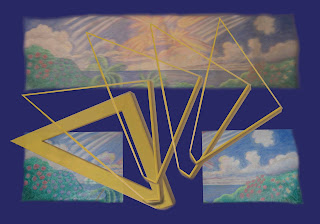

Artistic Statement
Project #2 __ Autumn 2009
Technoscapes: An Exploration of Images from Hayes Hall & from my own Paintings
In approaching the creation of the technoscapes for this project I assembled a variety of my own digital photographs including those of Hayes Hall, Hopkins Hall, some of my sculptures and paintings, and my garden. The first piece, Window with Doorway, is thus a digitally enhanced and created environment in which an image of a doorway can be seen through a window. The window is viewed from the outside of Hayes Hall and was transformed in Photo Shop by altering its coloring and tone, changing its perspective, cloning some of the brick texture where needed, and then masking the window with gradient masking and paint tools to create a space through which the painting within could be viewed. The doorway painting seen through the window is actually a composite of several of my paintings which were cropped, color-managed, and recombined into a new composition using a variety of Photo Shop tools, including Camera Raw for some of the original color adjustments. The second piece, Cosmic Comet, began as an exploration of an image of the main corridor of Hopkins Hall which I had transformed in Camera Raw, cropped, stretched, and color managed. My next step was to introduce images of my own paintings and sculptures into this transformed environment. However, as I worked on the piece I realized that the focus needed to shift to the image of the Comet painting which had been painted several years ago (part of a series done in various acrylic paints including metallic, iridescent, and interference paints). Thus the creative process led me to scrap the original plan and to work, instead, on the the Comet painting, transforming and enhancing it by placing it on a larger field, thus extending the original image into a virtual landscape. The extension was done with the use of a variety of Photo Shop tools starting with fills, gradients, and styles, then using the paint brush tool in various modes, and finally using the smudge tool and the motion blur filter to extend and accentuate the movement and flow already present in the original painting. At this point I am discovering that this combination of art and technology is increasingly presenting me with a very satisfying way of working, giving me the opportunity to explore, extend, even redefine themes and images which I have already developed in other media.
Project #2 __ Autumn 2009
Technoscapes: An Exploration of Images from Hayes Hall & from my own Paintings
































